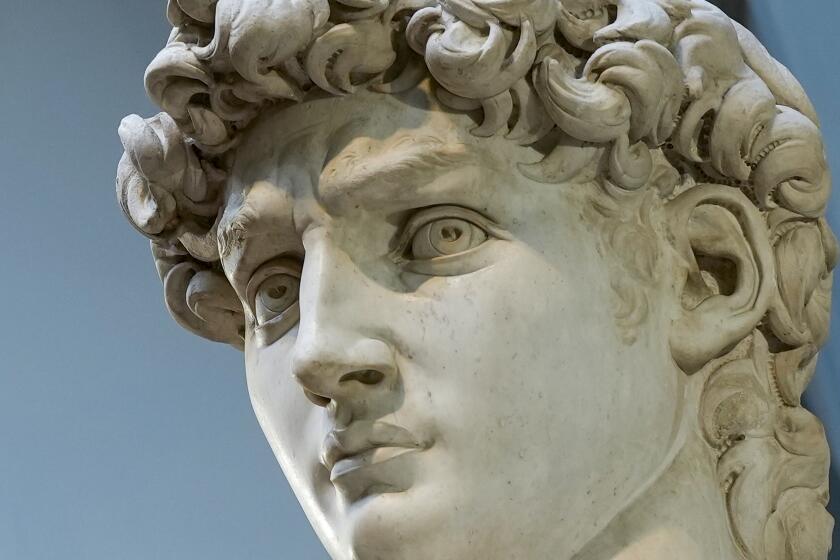L.A. history unfolds in map exhibit
Los Angeles’ road to the 21st century has been rocky -- and kooky -- according to an unusual exhibition that opened Wednesday at the downtown Central Library.
More than 100 maps reflecting changes and growth during the city’s existence are being displayed in a colorful exhibit called “L.A. Unfolded.”
There’s the mysterious “Mesmer City,” shown in 1924 as prosperously thriving between Culver City and Mar Vista. It turns out the detailed map was a subdivision promoter’s dreamy depiction of what life could be like at homesites “in the direction of Los Angeles’ growth toward the ocean.”
That growth eventually arrived, but Mesmer City didn’t.
A 1903 road map showing owners of the city’s 1,600 automobiles where dirt roads were safe enough to drive at 8 mph is included. With an eye toward more sales, cartographer Henry Rueger labeled his creation “Rueger’s Automobile and Miners Road Map” so he could tap into the vein of potential local prospectors and speculators.
One of Hollywood’s first movie star maps is there -- John Tyler’s 1945 “Guide Thru Starland” that pinpoints the homes of Harold Lloyd, Groucho Marx, Walter Pidgeon and dozens of their peers.
A 1940 map shows the site of Los Angeles’ blimp landing field. The airships hovered and docked near 3rd Street and Fairfax Avenue, where Park La Brea now stands.
“This is like a snapshot of the past,” said George Foelschow, a Koreatown computer programmer who was in the exhibit’s opening-day lunch-hour crowd. Among his interests are Los Angeles’ early trolley and interurban rail systems, and he was studying an old streetcar map.
The map show, at the library’s Getty Gallery, includes 112 of the city’s 100,000 maps. They will be on view through Jan. 22, said Glen Creason, co-curator of the exhibition.
He and co-curator Gloria Gerace picked a cross-section of local maps for the show. A few of the library’s other “treasures,” as Creason called them, were also put on display, even though they depict areas outside of Southern California.
“We didn’t want to do it chronologically and make it monolithic,” he said. “We looked for things with wide appeal.”
The exhibit straddles the line between science and art, according to Creason. Three of renowned artist-historian Jo Mora’s colorfully illustrated maps made the cut. His 1942 historical and recreational depiction of Los Angeles records its development from a sleepy pueblo to an exotic metropolis. “I render my message in the humorous manner as I’d rather find you with a smile of understanding than a frown of research,” Mora wrote on that map.
The city’s oldest map, the carefully plotted 1849 “Plan de la Ciudad de Los Angeles” by U.S. Army Lt. Edward Ord, is on one wall.
On another is the exhibit’s newest one -- an offbeat, hand-drawn 1987 map “done by a hippie in a Volkswagen bus” that celebrates Los Angeles’ Spanish plaza heritage of the 1760s alongside its Space Age Rocketdyne rocket engine test stand and nuclear breeder reactor technology of the 1960s.
“Imagine him doing all this work and selling it for $4,” Creason said of mapmaker Robert Waldmire, the man in the Volkswagen. “He includes all the wildlife and ecological features. There’s such minute detail. It’s like reading a thousand-page Henry James novel.”
Exhibition visitor Camille Macias, a 17-year-old Northridge high school senior, marveled at how Waldmire’s map brought context to things that her history books have taught her. “It says it wasn’t until 1847, basically, when white guys took over,” Camille said, squinting at the tiny, hand-printed text.
Skulls and crossbones mark military installations on the map. In Waldmire’s world, human development shares equal space with artful drawings of condors, humpback whales and endangered black rail marsh birds.
A wall-sized roll-up map of Los Angeles in 1941 is displayed next to an inscription from writer-musician Ry Cooder. He became enamored with the map while doing research at the library on Chavez Ravine for an album. Cooder now has a copy of cartographer Jack Renie’s map at his home.
“In the lower left-hand corner of the Metropolitan Map of Los Angeles, 1941, there’s a phone number: TRinity 6081. Ask for Jack J. Renie, Cartographer. . . . I look at my copy of this map each and every day. Such a comfort, somehow. A veritable Rosetta Stone, no doubt. I wonder if any photographs of Jack Renie exist? That would be nice, to put a face to it. How did he do the work? Amazing. Any artifacts of his business, or is it just the TRinity number?” Cooder wrote.
Gallery visitor Dan Crowley, an attorney who lives in Mar Vista, said he wants to acquire a copy of an 1884 city map by H.J. Stevenson for his office wall.
He said the old maps answer questions about early Los Angeles. But they also raise some unanswered ones.
Such as why are downtown streets laid out on a southwest-to-northeast angle until Hoover Street, where they are abruptly angled east-to-west?
That’s because the city’s original grid system that radiated from the plaza ended at Hoover, Creason said.
And what happened to the early downtown streets named Faith, Hope and Charity?
Faith became Olive Street and Charity was renamed Grand Avenue. As Los Angeles grew and thrived, people didn’t want to live on faith, Creason said.
And they certainly didn’t intend to live on charity.
--
More to Read
Start your day right
Sign up for Essential California for news, features and recommendations from the L.A. Times and beyond in your inbox six days a week.
You may occasionally receive promotional content from the Los Angeles Times.







